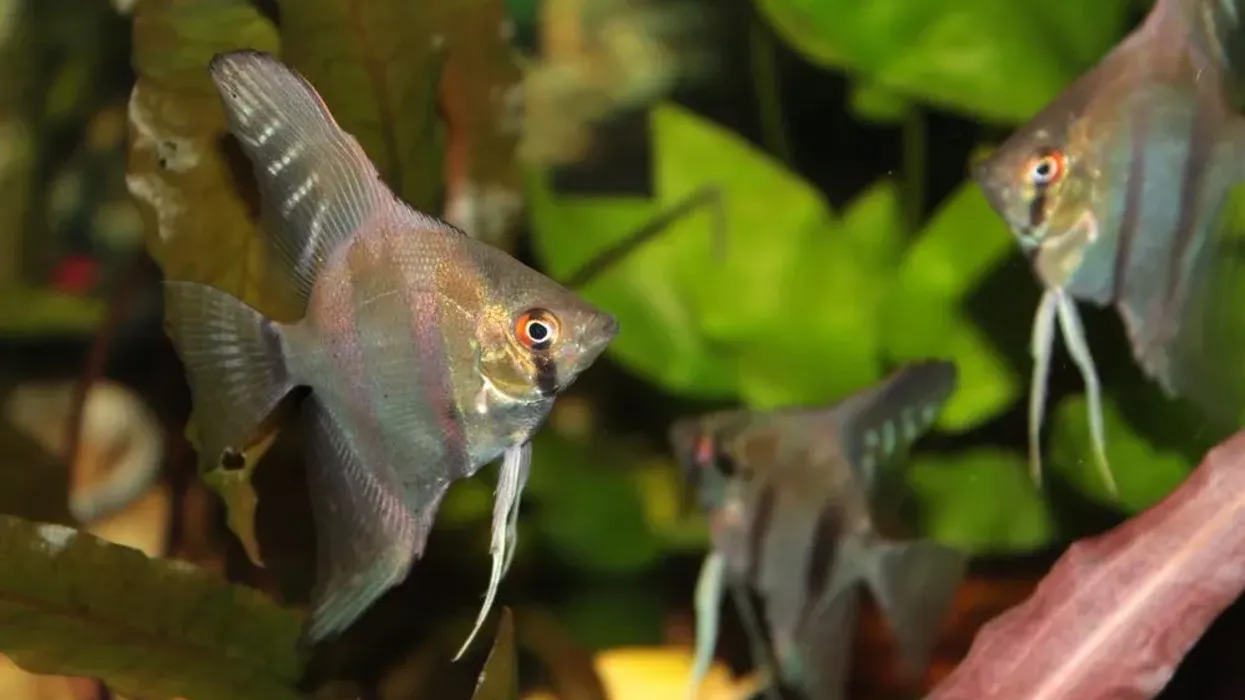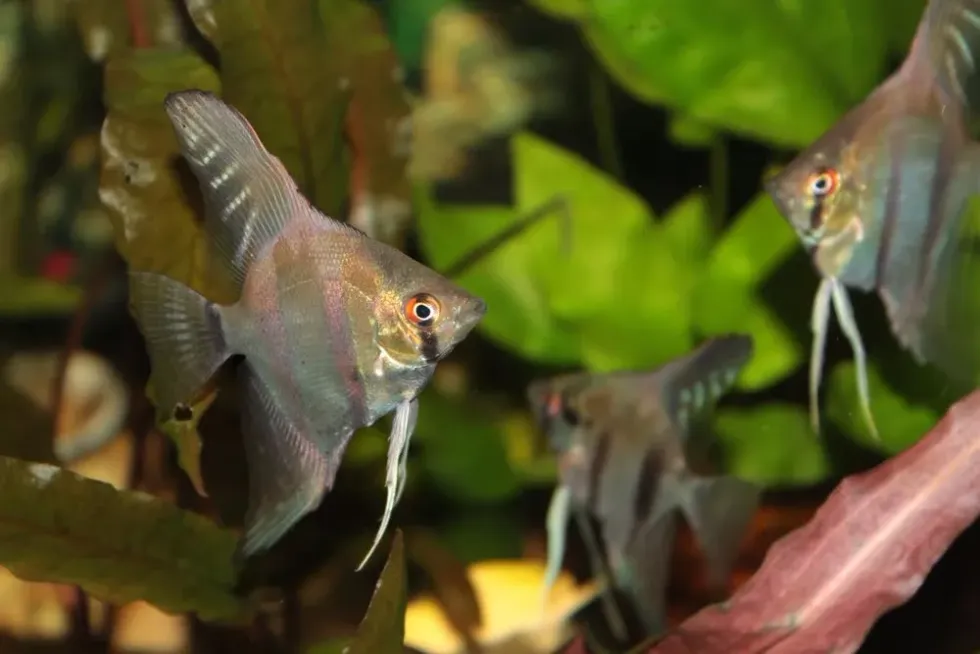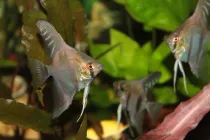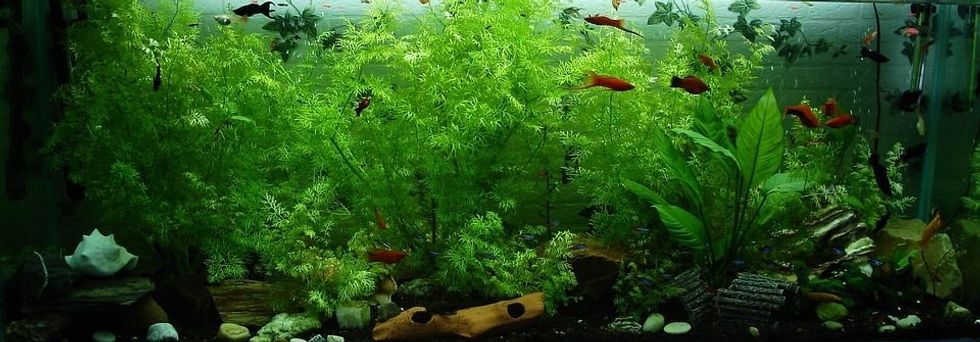Fun Altum Angelfish Facts For Kids

Altum angelfish are also known as P altum, Pterophyllum angelfish, or Orinoco angelfish. The altum angelfish one of three types of freshwater angelfish, that's the Pterophyllum scalare, Pterophyllum leopoldi, and the Pterophyllum altum. The altum is the largest of these fish, in fact, the word 'altum' comes for Greek for 'tall'.
In the wild, they can swim up to 9.8 ft (3 m) deep and prefer areas filled with plants. They travel in shoals of around 20 other fish and they originate from South America.
There are plenty of very surprising facts about these fascinating and mysterious creatures, read on to find out more! What's more, if you are thinking about keeping one as a pet, we can give you some more details.
If you are curious to discover more fish facts, take a look at our article on the Peacock cichlid and the rainbow cichlid.
Altum Angelfish Interesting Facts
What type of animal is an altum angelfish?
The Pterophyllum altum angelfish is a fish.
What class of animal does an altum angelfish belong to?
The altum angelfish (Pterophyllum) belongs to the fish class of animals within the animal kingdom.
How many altum angelfish are there in the world?
The exact number of Pterophyllum altum angels is not known at the oment. We do know there are approximately 90 different types of angelfish in the world including P. altum angelfish and P. scalare angelfish.
Where does an altum angelfish live?
Altum angels live in rivers and floodplains, and can also be found in a home aquarium.
What is an altum angelfish's habitat?
The Pterophyllum altum angelfish originates from countries and freshwater regions in South America. This includes the Orinoco River Basin, southern Venezuela, northern Brazil, and parts of Colombia.
In fact, many angelfish originate from South America, including the Peruvian altum angelfish (Pterophyllum scalare), which is very similar to the Pterophyllum altum angelfish. Freshwater altums like to live in clear, clean water, near the shoreline.
They prefer underwater areas with dense vegetation and lots of plants, and away from strong water flow. They are fish species that can also be kept in a home tank or a public aquarium.
Who do altum angelfish live with?
These fish love to pair up with another angelfish. They live happily with fish species bigger than themselves as they act as predators to many varieties of smaller fish species. They can also live with other types of common angelfish if you wanted to build a tropical fish aquarium.
They can live alongside species such as the tetra fish, rainbowfish, and rasboras fish. As altums grow bigger they can become aggressive towards one another, especially if they are protecting eggs. It's a good idea to keep males apart.
How long does an altum angelfish live?
They live for eight to 12 years on average. Roughly their lifespan is 10 years in the wild and a little less in captivity.
How do they reproduce?
A female angelfish will tidy and clear a surface to lay her eggs, and her male partner will then come along and fertilize the eggs. The eggs take roughly 60 hours to hatch, based on aquarium water conditions of 80 F (26.6 C).
If you are keeping them as a pet, do not give them any food until they are swimming independently. Females will naturally lay eggs in the water, with or without a male to come along and fertilize them.
A pregnant angelfish will have an enlarged belly, and this is a sign it will soon lay eggs. The parent angelfish will also spend a lot of time grooming one another.
They both become very protective of the eggs and will become aggressive to warn off other predators. This can be a problem if you are keeping them in an aquarium.
What is their conservation status?
Many angelfish are rated as a Least Concern species but these altum angelfish are listed as Not Extinct.
Altum Angelfish Fun Facts
What do altum angelfish look like?
Orinoco, or freshwater angels have a disk-like body shape that is relatively flat and they have a pointed shape nose. Both their anal and dorsal fin can grow long and wispy.
The color varies between fish, but mostly they are gray, green, or brown with silver colorings. Their back bears a brownish hue.
Their body has four main stripes, and this changes in tone depending on the angelfish's behavior. They do look very similar to the P. scalare (Pterophyllum scalare) but the altum angel has a higher number of fins.

* Please note that this is an image of an angelfish, not an Atlum angelfish specifically. If you have an image of an Atlum angelfish please let us know at hello@kidadl.com.
How cute are they?
Altum angels are certainly elegant and cute when it comes to tropical fish. Clownfish and angelfish were popularised by the classic Disney film 'Finding Nemo'. Angelfish are very cute, though be warned they are predatory fish! Also, note that although Nemo was brightly colored, altum angels are different in body color and they are more silver and brown.
How do they communicate?
Altum angels communicate in three interesting ways. Firstly they can communicate using chemicals, such as within their bile acids and urine. This is known as chemical marking.
They can signal warnings to predator fish and let other angelfish know about their reproductive status. The second way they communicate is using sonic acoustic communication. This means they use sonic muscles to create a sound.
Although we can't hear it as humans, other fish species can pick up these signals. They use this communication when preying on other fish or when mating. The third primary way the Pterophyllum altum communicates is visual.
They can use their fins and change the color and pattern shape on their skin. Altum angels tend to change the intensity of the color within their striped bars. In the wild, they also have the ability to camouflage.
How big is an altum angelfish?
Altums can grow as tall as 9-13 in (20-33 cm) and up to 7 in (18 cm) in length. They are one of the largest species of common angelfish.
Males tend to be a little bit bigger than females, but it can be tricky to tell them apart. A male usually has a more pointed head and a taller body. They are twice the size of the average pet goldfish.
How fast can an altum angelfish swim?
Altums are not the fastest fish around, however, they are very graceful. They like to chase other angelfish in the sea.
How much does an altum angelfish weigh?
This species weighs around 0.2 lb (90 g). It's important that altums have a good diet to build up their strength and weight.
What are their male and female names of the species?
This angelfish (Pterophyllum altum) does not have a specific name for males and females.
What would you call a baby altum angelfish?
A baby angelfish (Pterophyllum altum) is known as a 'fry'. When they are able to feed independently, baby altums are known as fingerling fish. If you have them as a pet, do not give them any food until they can feed independently in the water.
What do they eat?
In the wild, altums enjoy a varied diet including shrimps, crustaceans, worms, and smaller fish. Most petaltums are wild-caught. They like live food such as brine shrimp. These fish are quite known to be greedy, so make sure to feed them in smaller portions otherwise they will swell up for a few hours.
Are they dangerous?
Angelfish are not dangerous or poisonous. Well, unless you are a little brine shrimp! They are not likely to fight other fish in the aquarium water, although they are very territorial fish.
Would they make a good pet?
Many people become confused about whether they have an actual altum angelfish species or another type (even in pet stores) as they look very similar to other species. The most common angelfish species is the angelfish Pterophyllum scalare (P Scalare).
This is because the Pterophyllum altum is very difficult to breed in captivity. Many pet altums are wild-caught and very sought after by tropical fish enthusiasts.
Although they make beautiful and elegant pets, they are better suited to those with plenty of experience keeping tropical fish. Water conditions and tanks must be well-matched, and they prefer live feeding (eating live fish) such as brine shrimp.
Did you know...
They pair up for life! Angelfish like to partner up and form a long-term relationship with another angelfish.
They protect each other from harm and other suiters. Even after one of them dies or is removed, many breeders report the other altum angel does not replace his first love, and will not breed or pair up with another altum angel.
How to care for altum angelfish
To care for an altum angelfish, it's crucial to have the perfect temperature, tank, and diet for your freshwater fish. Aquarium water conditions must be soft and acidic, with a pH between 4.8 and 6.2. They also enjoy plenty of plants and sand at the bottom of the tank. Such plants include the Amazon sword and Java ferns.
The ideal water temperature to keep this species would be between 78-84 F (26-29 C). Poor water quality can lead to angel health issues, such as fin rot.
Be sure to check the water quality frequently and monitor the water temperature, as, in summer months, the aquarium can heat up quickly. Be careful not to over-decorate the aquarium too, as too many objects can cause a fin to get trapped or damaged.
Tall aquarium tanks are best for this species; as they grow big, they will need around 55 gallons (200 l) of water.
This is a very big aquarium, so make sure you have space! Be sure not to overpopulate your tank with too many fish.
Their diet consists of plenty of live brine shrimp, high-grade flaked food, and blood worms which make a great treat. They also enjoy feeding on spinach and lettuce as the occasional snack food.
It's preferred to do a 20-25% water change approximately every two weeks and use a good water tank filter or an aquarium siphon gravel cleaner. Ideally, place the aquarium in a calm area, as busy places can cause the fish to feel very afraid, and sudden changes in light and loud noises can affect them badly.
They are known to swim into the tank and injure themselves. If you notice any sudden changes or drooping in their fin, find a vet experienced in taking care of this aquarium species.
Naming the altum angelfish
The altum angelfish variety was first described by Jacques Pellegrin (1873 – 1944) in 1903. 'Altum' comes from the Greek word for 'tall', due to their tall body when compared to other common angelfish species.
Here at Kidadl, we have carefully created lots of interesting family-friendly animal facts for everyone to discover! Learn more about some other fish including pumpkinseed sunfish, or gourami.
You can even occupy yourself at home by drawing one on our Altum Angelfish coloring pages.
We Want Your Photos!
More for You
See All
Bachelor's degree specializing in Speech Therapy and Psychology, Postgraduate degree specializing in Dysphagia

Dayna ClarkeBachelor's degree specializing in Speech Therapy and Psychology, Postgraduate degree specializing in Dysphagia
A true "linguaphile," Dayna's upbringing in rural Devon exposed her to three languages spoken at home. After pursuing a Bachelor's degree in Speech-Language Pathology at the University of Reading, she embarked on a fulfilling career as a Speech and Language Therapist, specializing in early intervention for children with special educational needs. Additionally, she provides support to adults and teenagers dealing with dysfluency. She also has a postgraduate degree in Dysphagia from the Universitat Autònoma de Barcelona.
Bachelor of Arts specializing in English Language and Literature, Master of Arts specializing in Philosophy and Religious Studies

Tehil DavidBachelor of Arts specializing in English Language and Literature, Master of Arts specializing in Philosophy and Religious Studies
Tehil David Singh is a fact checker with a Bachelor's degree in English literature from St.Xavier's College, Palayamkottai, and a Master's degree in Philosophy, and Religion from Madurai Kamaraj University. He has a passion for writing and hopes to become a story writer in the future. Tehil has previously interned in content writing and has been a content creator for the last three years. In his personal life, he enjoys singing, songwriting, performing, and writing stories.
Disclaimer
1) Kidadl is independent and to make our service free to you the reader we are supported by advertising. We hope you love our recommendations for products and services! What we suggest is selected independently by the Kidadl team. If you purchase using the Buy Now button we may earn a small commission. This does not influence our choices. Prices are correct and items are available at the time the article was published but we cannot guarantee that on the time of reading. Please note that Kidadl is a participant in the Amazon Services LLC Associates Program, an affiliate advertising program designed to provide a means for sites to earn advertising fees by advertising and linking to Amazon. We also link to other websites, but are not responsible for their content.
2) At Kidadl, we strive to recommend the very best activities and events. We will always aim to give you accurate information at the date of publication - however, information does change, so it’s important you do your own research, double-check and make the decision that is right for your family. We recognise that not all activities and ideas are appropriate for all children and families or in all circumstances. Our recommended activities are based on age but these are a guide. We recommend that these ideas are used as inspiration, that ideas are undertaken with appropriate adult supervision, and that each adult uses their own discretion and knowledge of their children to consider the safety and suitability. Kidadl cannot accept liability for the execution of these ideas, and parental supervision is advised at all times, as safety is paramount. Anyone using the information provided by Kidadl does so at their own risk and we can not accept liability if things go wrong.
3) Because we are an educational resource, we have quotes and facts about a range of historical and modern figures. We do not endorse the actions of or rhetoric of all the people included in these collections, but we think they are important for growing minds to learn about under the guidance of parents or guardians.







